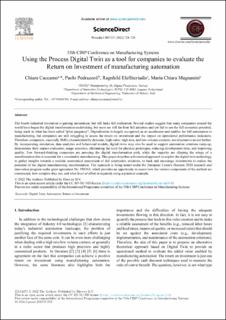| dc.description.abstract | The fourth industrial revolution is gaining momentum, but still lacks full realization. Several studies suggest that many companies around the world have begun the digital transformation undertaking, but most are still far from full adoption and yet fail to see the full economic potential, being stuck in what has been called "pilot purgatory”. Digitalization is largely recognized as an accelerator and enabler for full automation in manufacturing, but companies are still struggling to assess the return on investment and the impact on operational performance indicators. Therefore, companies, especially SMEs characterized by dynamic, high-value, high-mix, and low-volume contexts, are reluctant to invest further. By incorporating simulation, data analytics and behavioral models, digital twins may also be used to support automation solutions ramp-up, demonstrate their impact evaluation, usage scenarios, eliminating the need for physical prototypes, reducing development time, and improving quality. Few forward-thinking companies are pursuing the digital transformation path, while the majority are clipping the wings of a transformation that is essential for a sustainable manufacturing. This paper describes a theoretical approach to exploit the digital twin technology to gather insights towards a realistic economical assessment of full automation solutions, to back and encourage investments to realize the potential of the digital manufacturing transformation. The approach is being tested under the European Union’s Horizon 2020 research and innovation program under grant agreement No. 958363, which provides an opportunity to assess how the various components of the method are constructed, how complex they are, and what level of effort is required, using a practical example. | en_US |

